Isolation of Pure Cultures from a Mixed Population
Microorganisms exist in nature as mixed populations. However, to study microorganisms in the laboratory, we must have them in the form of a pure culture; that is, one in which all organisms are descendants of the same organism.
Two major steps are involved in obtaining pure cultures from a mixed population:
 |
| Figure 16 Obtaining pure cultures from an isolation plate. |
- First, the mixture must be diluted until the various individual microorganisms become separated far enough apart on an agar surface that after incubation they form visible colonies isolated from the colonies of other microorganisms. This plate is called an isolation plate.
- Then, an isolated colony can be aseptically “picked off” the isolation plate.
Before removing bacteria from the petri plate, first cool the loop by sticking it into the agar away from any growth.
After incubation, all organisms in the new culture will be descendants of the same organism; that is, a pure culture.
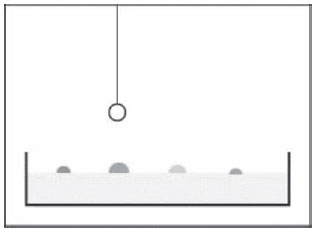 |
| Figure 17 Picking off a single colony from a plate culture. |
Streak Plate Method of Isolation
The most common way of separating bacterial cells on the agar surface to obtain isolated colonies is the streak plate method. It provides a simple and rapid method of diluting the sample by mechanical means. As the loop is streaked across the agar surface, more and more bacteria are rubbed off until individual separate organisms are deposited on the agar. After incubation, the area at the beginning of the streak pattern will show confluent growth, while the area near the end of the pattern should show discrete colonies. Micrococcus luteus produces a yellow, water- insoluble pigment. Escherichia coli is nonchromogenic.
The Pour Plate and Spin Plate Methods of Isolation
Another method of separating bacteria is the pour plate method. With the pour plate method, the bacteria are mixed with melted agar until evenly distributed and separated throughout the liquid. The melted agar is then poured into an empty plate and allowed to solidify. After incubation, discrete bacterial colonies can then be found growing both on the agar and in the agar.
 |
| Figure 18 Single isolated colonies of Micrococcus luteus and Escherichia coli growing on trypticase soy agar. |
Escherichia coli growing on trypticase soy agar. The spin plate method involves diluting the bacterial sample in tubes of sterile water, saline, or broth. Small samples of the diluted bacteria are then pipetted onto the surface of agar plates. A sterile, bent-glass rod is then used to spread the bacteria evenly over the entire agar surface. In the next experiments, we will use this technique as part of the plate count method of enumerating bacteria.
Use of Specialized Media
To supplement mechanical techniques of isolation such as the streak plate method, many special-purpose media are available to the microbiologist to aid in the isolation and identification of specific microorganisms. These special purpose media fall into 4 groups: selective media, differential media, enrichment media, and combination selective and differential media.
Selective media
A selective medium has agents added that will inhibit the growth of one group of organisms, while permitting the growth of another. For example, Columbia CNA agar has the antibiotics colistin and nalidixic acid added, which inhibit the growth of Gram-negative bacteria, but not the growth of Gram-positives. It is, therefore, said to be selective for Gram-positive organisms, and would be useful in separating a mixture of Gram-positive and Gram-negative bacteria.
Differential media A differential medium contains additives that cause an observable color change in the medium when a particular chemical reaction occurs. They are useful for differentiating bacteria according to some biochemical characteristic. In other words, they indicate whether or not a certain organism can carry out a specific biochemical reaction during its normal metabolism. Many such media will be used in future labs to aid in the identification of microorganisms.
Enrichment media
An enrichment medium contains additives that enhance the growth of certain organisms. This is useful when the organism you wish to culture is present in relatively small numbers compared to the other organisms growing in the mixture.
Combination selective and differential media
A combination selective and differential medium permits the growth of one group of organisms while inhibiting the growth of another. In addition, it differentiates those organisms that grow based on whether they can carry out particular chemical reactions. For example, Eosin Methylene Blue (EMB) agar is selective for Gram-negative bacteria. The dyes eosin Y and methylene blue found in the medium inhibit the growth of Gram-positive bacteria, but not the growth of Gram-negatives. In addition, it is useful in differentiating the various Gram-negative enteric bacilli belonging to the bacterial family Enterobacteriaceae. The appearance of typical members of this bacterial family on EMB agar is as follows:
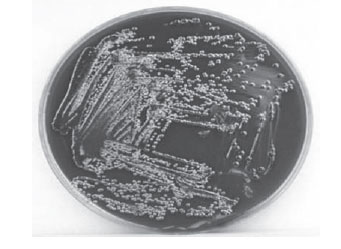 |
| Figure 19 Escherichia coli on EMB agar. |
Only Gram-negative bacteria grow on EMB agar. (Gram-positive bacteria are inhibited by the dyes eosin and methylene blue added to the agar.) Based on its rate of lactose fermentation, Escherichia coli produces dark, blue-black colonies with a metallic green sheen on EMB agar.
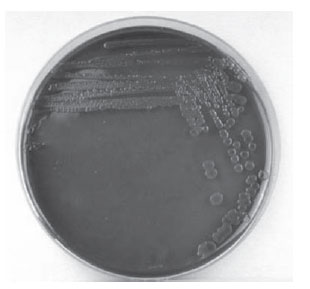 |
| Figure 20 Enterobacter aerogenes growing on EMB agar. |
Only Gram-negative bacteria grow on EMB agar. (Gram-positive bacteria are inhibited by the dyes eosin and methylene blue added to the agar.) Based on its rate of lactose fermentation, Enterobacter produces large, mucoid, pink-topurple colonies with no metallic green sheen on EMB agar.
Klebsiella: large, mucoid, pink-to-purple colonies with no metallic sheen
Salmonella and Shigella and Proteus: large, colorless colonies
Shigella: colorless to pink colonies.
The color changes in the colonies are a result of bacterial fermentation of the sugar lactose, while colorless colonies indicate lactose nonfermenters. There are literally hundreds of special-purpose media available to the microbiologist. We will combine both a mechanical isolation technique (the streak plate) with selective and selective-differential media to obtain pure cultures from a mixture of bacteria.
Media: One plate of each of the following media: trypticase soy agar, Columbia CNA agar, and EMB agar.
Organisms: A broth culture containing a mixture of one of the following Gram-positive bacteria and one of the following Gram-negative bacteria:
- Possible Gram-positive bacteria:
- Micrococcus luteus: A Gram-positive coccus with a tetrad or sarcina arrangement; produces circular, convex colonies with a yellow, waterinsoluble pigment on trypticase soy agar.
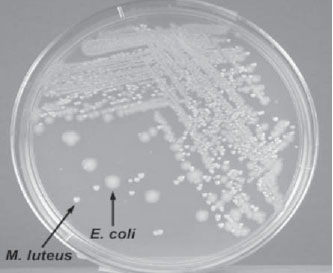
Figure 21 Isolation plate: Mixture of Escherichia coli and Micrococcus luteus grown on TSA.
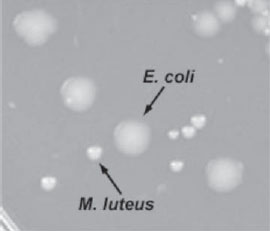
Figure 22 Close-up view of Escherichia coli and Micrococcus luteus grown on TSA
- Staphylococcus epidermidis: A Gram-positive coccus with a staphylococcus arrangement; produces circular, convex, nonpigmented colonies on trypticase soy agar.
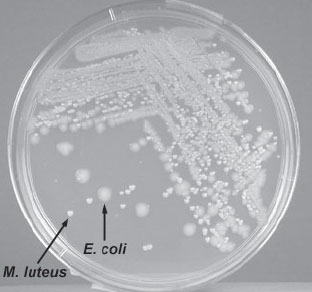
Figure 24 Isolation plate: Mixture of Escherichia coli and Micrococcus luteus grown on TSA.
- Escherichia coli: A Gram-negative bacillus; produces irregular, raised, nonpigmented colonies on trypticase soy agar.
- Enterobacter aerogenes: A Gram-negative bacillus; produces irregular raised, nonpigmented, possibly mucoid colonies on trypticase soy agar.
- Micrococcus luteus: A Gram-positive coccus with a tetrad or sarcina arrangement; produces circular, convex colonies with a yellow, waterinsoluble pigment on trypticase soy agar.
During the next 3 labs you will attempt to obtain pure cultures of each organism in your mixture and determine which 2 bacteria you have. Today you will try to separate the bacteria in the mixture in order to obtain isolated colonies; in the next lab you will identify the 2 bacteria in your mixture and pick off single isolated colonies of each of the 2 bacteria in order to get a pure culture of each. In the following lab you will prepare microscopy slides of each of the 2 pure cultures to determine if they are indeed pure.
Procedure
- First, attempt to obtain isolated colonies of the 2 organisms in your mixture by using mechanical methods on an all-purpose growth medium, trypticase soy agar. Streak the mixture on a plate of trypticase soy agar using one of the 2 streaking patterns.
- Streak the same mixture for isolation on a plate of Columbia CNA agar (selective for Gram-positive bacteria).
- Micrococcus luteus growing on Columbia CNA agar.
- Staphylococcus epidermidis growing on Columbia CNA agar.
- Streak the same mixture for isolation on a plate of EMB agar (selective for Gram-negative bacteria and differential for certain members of the bacterial family Enterobacteriaceae).
- Escherichia coli growing on EMB agar.
- Enterobacter aerogenes growing on EMB agar.
- Incubate the 3 plates at 37°C until the next lab period.
- Observe isolated colonies on the plates of trypticase soy agar, Columbia CNA agar, and EMB agar. Record your observations and conclusions.
Trypticase soy agar
Observations:
Conclusions:
Columbia CNA agar
Observations:
Conclusions:
EMB agar
Observations:
Conclusions: - Using any of the 3 plates, pick off a single isolated colony of each of the 2 organisms in your original mixture and aseptically transfer them to separate plates of trypticase soy agar. When picking off single colonies, remove the top portion of the colony without touching the agar surface itself to avoid picking up any inhibited bacteria from the surface of the agar. Use your regular plate streaking pattern to inoculate these plates and incubate at 37°C until the next lab period. These will be your pure cultures.
Discussion
- Given a mixture of 2 bacteria and plates of trypticase soy agar, describe the steps you would take in order to eventually obtain pure cultures of each organism.
- Define: selective medium, differential medium, enrichment medium, and combination selective-differential medium.
- Describe the usefulness of Columbia CNA agar and EMB agar.
- Describe how each of the following would appear when grown on EMB agar:
- Escherichia coli
- Enterobacter aerogenes
- Salmonella.
- Escherichia coli
Procedure
- Using the streak plate method of isolation, obtain isolated colonies from a mixture of microorganisms.
- Pick off isolated colonies of microorganisms growing on a streak plate and aseptically transfer them to sterile media to obtain pure cultures.
Results
When given a plate of Columbia CNA agar or EMB agar showing discrete colonies, correctly interpret the results.




